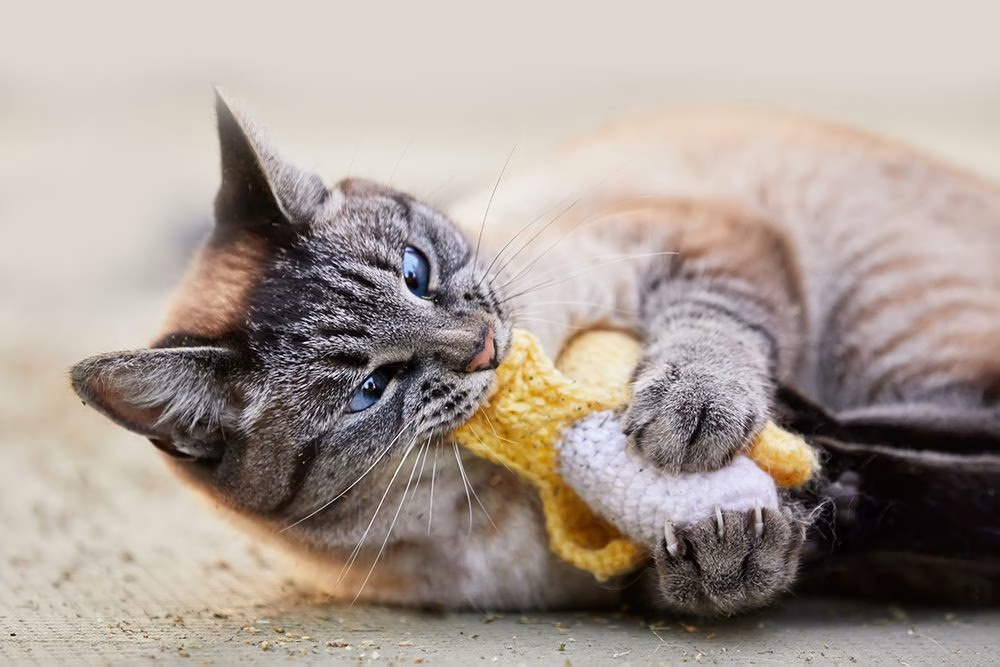Does your cat have a peculiar habit of chewing on things like plastic, fabric, or cardboard? While this may seem odd or even cute at first, it could be a sign of a condition called pica. Pica in cats refers to the compulsive urge to eat or chew on non-food items, and it can point to underlying health or behavioral issues.
In this post, we’ll explore the causes, symptoms, and solutions for pica to help you understand and manage this condition in your feline companion.

What Causes Pica in Cats?
Pica can stem from a variety of factors, including physical, psychological, and environmental influences:
1. Medical Issues
- Nutritional Deficiencies: A diet lacking essential nutrients or minerals might drive your cat to seek them elsewhere, leading to pica.
- Gastrointestinal Problems: Disorders like inflammatory bowel disease (IBD) may trigger unusual eating habits.
- Dental Pain: Sore gums or teeth may cause your cat to chew on objects for relief.
2. Psychological Triggers
- Stress and Anxiety: Changes in the household, such as a move, a new pet, or a new routine, can create stress and lead to compulsive behaviors like chewing.
- Boredom: Cats without sufficient stimulation or enrichment might resort to pica to entertain themselves.
3. Genetics
Certain breeds, such as Siamese and Burmese cats, are more prone to pica due to inherited tendencies.
4. Early Weaning
Kittens weaned too early from their mothers may develop an oral fixation, increasing the likelihood of pica.
Common Items Cats with Pica May Chew
Cats with pica may target a wide range of non-food items, including:
- Plastic bags
- Paper or cardboard
- Fabric (such as wool or blankets)
- Rubber bands or hair ties
- Electrical cords
These behaviors can be harmful, as ingesting these items might lead to choking or blockages.

How to Manage and Treat Pica in Cats
If you suspect your cat has pica, it’s essential to take steps to address the issue:
1. Consult Your Veterinarian
Your vet can help rule out any medical causes of pica, such as nutritional deficiencies or gastrointestinal disorders. Blood tests and dietary evaluations may be necessary.
2. Enrich Their Environment
- Provide engaging toys, scratching posts, and climbing structures to keep your cat entertained.
- Introduce interactive toys, such as food puzzles, to mimic hunting behavior and keep their minds active.
3. Remove Temptations
- Keep harmful items like cords, plastic, or toxic plants out of reach.
- Use bitter sprays or deterrents on items your cat tends to chew.
4. Adjust Their Diet
- Ensure your cat is receiving a nutritionally complete and balanced diet.
- Consult your vet about adding high-fiber foods or safe chewable treats to satisfy their chewing instinct.
5. Address Stress or Anxiety
- Maintain a consistent routine to reduce stress for your cat.
- Use calming aids, such as pheromone diffusers (e.g., Feliway), to create a soothing environment.
6. Behavioral Training
Redirect your cat’s chewing behavior by offering appropriate alternatives, like dental chews or catnip-filled toys, and reward positive behavior.

When to Seek Professional Help
If your efforts don’t curb the behavior or if your cat is ingesting dangerous items, consult a veterinary behaviorist. They can create a tailored plan to address your cat’s specific needs.
Pica in cats is more than just a quirky habit—it can signal underlying health or emotional issues that need attention. With proper care, a safe environment, and professional guidance, you can help your cat overcome pica and lead a healthier, happier life.
If you’ve noticed your cat exhibiting signs of pica, don’t wait to take action. While this post focuses on feline pica, pet parents of dogs might also find themselves wondering, “Why is my dog eating non-food items?” Be sure to check out Pica in Dogs: What It Is and How to Stop It for Good! for helpful insights specific to dogs. Together, we can keep our pets safe, happy, and thriving.


